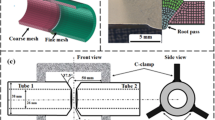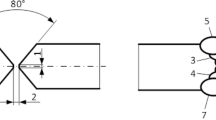Abstract
Modifying the level of mostly detrimental welding residual stresses already during the welding process would be highly attractive as time- and cost-consuming post processing may be prevented. The nature of stress buildup during welding-associated cooling is highly affected by phase transformations. Up to now, it is not clear in which way this is applicable to real component welding exhibiting high shrinkage restraint and complex heat input. In this study, two different low transformation temperature (LTT) alloys have been investigated concerning the stress development in restrained multi-run butt welding in order to evaluate the potential of stress reduction. Pulsed gas metal arc welding (P-GMAW) welding was executed on a testing facility designed to simulate real lifelike restraint conditions of component weldments. The effect of reduced MS-temperatures and the heat control on the globally acting stresses was monitored by in-situ measurement of the reaction forces during welding fabrication. Additional local residual stress measurements allowed analyzing global as well as local loading of the welded construction. Although phase transformation has a significant influence on unloading the joint during each weld pass, the reaction stress upon cooling to room temperature seems to be determined mainly by the heat input. On the surface, low longitudinal residual stresses were observed in case of LTT whereas transverse residual stresses are less affected.









Similar content being viewed by others
References
Nitschke-Pagel T, Wohlfahrt H (2002) Residual stresses in welded joints—sources and consequences. Mater Sci Forum 404–407:215–226. doi:10.4028/www.scientific.net/MSF.404-407.215
Kromm A (2012) Henry Granjon prize competition 2011 winner category b: “materials behaviour and weldability” exploring the interaction of phase transformation and residual stress during welding by synchrotron diffraction. Weld World 56:2–11
Satoh K, Ueda Y (1977) Japanese studies on structural restraint severity in relation to weld cracking (Preliminary report). Weld World 15:155–162
Kannengiesser T, Boellinghaus T, Neuhaus M (2013) Effects of the load history on the residual stress distribution in welded components. Weld World 50:11–17. doi:10.1007/BF03266531
Schroepfer D, Kannengiesser T (2014) Correlating welding reaction stresses and weld process conditions for high-strength steel S960QL. Weld World 58:423–432. doi:10.1007/s40194-014-0127-x
Nitschke-Pagel T, Wohlfahrt H, Dilger K (2013) Application of the local fatigue strength concept for the evaluation of post weld treatments. Weld World 51:65–75. doi:10.1007/BF03266610
Kromm A, Dixneit J, Kannengiesser T (2014) Residual stress engineering by low transformation temperature alloys—state of the art and recent developments. Weld World 58:729–741. doi:10.1007/s40194-014-0155-6
Jones WKC, Alberry PJ (1977) A model for stress accumulation in steels during welding. In: Residual Stress. welded Constr. their Eff. London, pp 15–26
Ramjaun TI, Stone HJ, Karlsson L et al (2014) Effects of dilution and baseplate strength on stress distributions in multipass welds deposited using low transformation temperature filler alloys. Sci Technol Weld Join 19:461–467. doi:10.1179/1362171814Y.0000000209
Francis JA, Stone HJ, Kundu S, et al. (2007) Transformations temperatures and welding residual stresses in ferritic steels. Proc ASME Press. Vessel. Pip. Div
Ramjaun T, Stone HJ, Karlsson L et al (2014) Effect of interpass temperature on residual stresses in multipass welds produced using low transformation temperature filler alloy. Sci Technol Weld Join 19:44–51. doi:10.1179/1362171813Y.0000000162
Dai H, Moat RJ, Withers PJ (2011) Modelling the interpass temperature effect on residual stress in low transformation temperature stainless steel welds. In: ASME Press. Vessel. Pip. Conf. Baltimore, pp 1451–1458
N.N. (2012) DIN EN ISO 16834 Welding consumables—wire electrodes, wires, rods and deposits for gas shielded arc welding of high strength steels—classification (ISO 16834:2012)
Steven W, Haynes AG (1956) The temperature of formation of martensite and bainite in low-alloy steels. J Iron Steel Inst:349–359
N.N. (2007) Data sheet filler material BÖHLER X 90-IG
S. Vanrostenberghe, M. Clarin, Y. Shin, B. Droesbeke, V. Van der Mee, M. Doré, G. Marquis, J. Parantainen, T. Kannengießer ZB (2015) Improving the fatigue life of high strength steel welded structures by post weld treatments and specific filler material. doi: 10.2777/705266
N.N. (1996) DIN EN ISO 13916 welding—guidance on the measurement of preheating temperature, interpass temperature and preheat maintenance temperature
N.N. (2001) DIN EN 1011–2 welding—recommendation for welding of metallic materials—Part 2: arc welding of ferritic steels
Alexandrov BT, Lippold JC (2006) A new methodology for studying phase transformations in high strength steel weld metal. In: International A (ed) 7th Int. Trends Weld. Res. Conf. Proc. Pine Mountain, USA, 975–980
Kromm A, Kannengiesser T (2013) Effect of martensitic phase transformation on stress build-up during multilayer welding. Mater Sci Forum 768–769:660–667. doi:10.4028/www.scientific.net/MSF.768-769.660
Acknowledgments
The authors would like to especially acknowledge the German Research Foundation (DFG) for funding parts of this work (KA 1807/4-1, GI 376/4-1), Lincoln Electric Europe for provision of welding consumables and EWM AG for the support.
Author information
Authors and Affiliations
Corresponding author
Additional information
Recommended for publication by Commission X - Structural Performances of Welded Joints - Fracture Avoidance
Rights and permissions
About this article
Cite this article
Dixneit, J., Kromm, A., Hannemann, A. et al. In-situ load analysis in multi-run welding using LTT filler materials. Weld World 60, 1159–1168 (2016). https://doi.org/10.1007/s40194-016-0373-1
Received:
Accepted:
Published:
Issue Date:
DOI: https://doi.org/10.1007/s40194-016-0373-1




